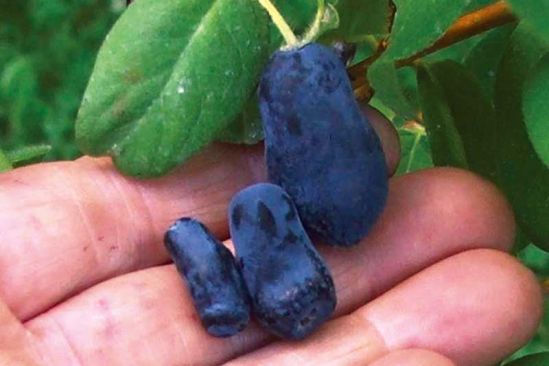Ankaret Dean | Jul 16, 2015
Lanark County Master Gardeners
I wonder how many people have met the comparatively new shrub called Honeyberry.
The University of Saskatchewan began breeding Honeyberries in 2002 using the line from Russia, Japan and the Kuril Islands, and they produced a fruit that is sweeter and superior in taste to many other Honeyberry varieties on the market. The berries are also larger and more easily detached from the plant. Interestingly, Honeyberries belong to the honeysuckle family. They are ideal for our climate, being hardy to -55°F and the blossoms can withstand 20°F.
The early blooming varieties bear fruit before strawberries and the later blooming varieties a few weeks later. They will grow in most soils in a wide range of pH levels, unlike blueberries. Some varieties can grew up to 8 feet high and about 4 feet across.
The flavor of Honeyberries is very hard to describe; it may be best to just say it's a mystery berry, reminding some people of blackberries, cherries or even grapes. The berries are small and oval, with a very thin skin and can be very easily picked or shaken off the bush. Similar to blueberries, they are very high in anti-oxidants. They can be eaten fresh or used in baking for pies or desserts. They also freeze well.
It is important to have at least two varieties to ensure pollination. They should be placed between four and six feet apart and planted a couple of inches deeper than the original depth. Keep them well watered the first few years to promote deep root growth. Lightly fertilize in the spring with composted material, and prune out branches when the bush gets too dense. Apparently some varieties can produce 10 or more pounds of berries after five years, and the lifespan is 50 or more years. The berries are attractive to birds, and deer and rabbits also enjoy the leaves. This newly developed Honeyberry, also known as Haskap, may become the new fruit to grow in the future.
Enjoy The Edible Garden Newsletter published monthly by Lanark County Master Gardeners and available on our website www.lanarkmg.blogspot.com or follow us on Facebook or Twitter @lanarkmg.
More Stories
- Latest CUPW Job Action Stops Postal Delivery Of The Frontenac News Forcing Alternate Plans
- Opponents of Barbers Lake Gravel Pit Pack Ag Hall in McDonalds Corners
- Bobsleigh Olympian Jay Dearborn At Mikes Pizza In Sydenham
- The Loins Club Of and O'Lakes Roar
- North Frontenac Back Roads Studio Tour - September 27 and 28
- Sunday Market Vendors Give Back
- George Street Work As Town Hall Renovation Nears Completion
- One Way Street Plan Hits A Dead End - Central Frontenac Council, September 9
- Global Gardening
- No Winner Yet in Catch The Ace But Fundraising Target Met

